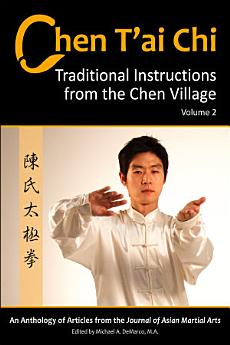Chen T'ai Chi: Traditional Instructions from the Chen Village, Volume 2
About this ebook
Chen-style taijiquan formulated during the days of military strategist Qi Jiguang (1528–1587), and its founder is considered to be militia battalion commander Chen Wangting (1600–1680). The art evolved. Its mystique remains fundamentally a true fighting art, including bare-handed forms and applications, plus an arsenal of weapons that includes the spear, straight sword, broadsword, and halberd. Then there are the associated training methods used to master this complete system, such as qigong, push-hands, and standing post. All of these practices are infused with knowledge associated with the physical and mental aspects of the human condition.
Chen style encompasses a complete martial system. It has a deserved reputation for its combative efficiency, but also as a health-nurturing modality. The vastness of the Chen-style curriculum is way beyond the scope of most people to fully learn, so practitioners focus on what they can handle. Usually a solo routine is sufficient. Since all taiji styles stem from the original Chen family system, the Chens certainly share in the credit for taiji’s popularity in general, especially as an exercise purely for health benefits.
Regardless of taiji style—be it Chen, Yang, Wu, Sun, Hao, or other—any serious taiji practitioner or scholar should have some understanding of the Chen family roots to get a vision of the whole tree. This two-volume anthology brings much of the rich heritage conveniently together for your reading. In this second volume, there is a special emphasis on nurturing the internal aspects for health as well as for combative skills. You will find clear explanations outlining each step in the learning process toward mastering Chen-style taiji. Chapters included here clarify what proper training entails and why much time and effort (gongfu) are necessary to gain results.
In addition to the detailed history and penetrating philosophy you’ll find here, perhaps of greater importance are the clear explanations outlining each step in the learning process toward mastering Chen-style taiji. Only a very high-level teacher can understand what methods of instruction work best. Students don’t know; that’s why they should follow a teacher’s instructions as closely as possible. Chapters included here clarify what proper training entails and why much time and effort (gongfu) are necessary to gain results. As echoed among practitioners in taiji’s birthplace: “If you drink water from Chen Village, your feet know how to kick.” This two-volume edition brings you to the village for traditional instruction.
Ratings and reviews
About the author
Authors: Michael A. DeMarco, M.A. and A. Edwin Matthews; Adam Wallace; Yaron Seidman, L.Ac.; Bosco Seung-Chul Baek, B.S.;
Michael Rosario Graycar and Rachel Tomlinson, M.Ed.








